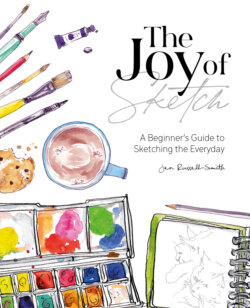Читать книгу The Joy of Sketch - Jen Russell-Smith - Страница 8
На сайте Литреса книга снята с продажи.
ОглавлениеEXERCISE
Colour chart
This might look a bit technical and artistic, but it’s really very simple. Plus it’s a great way to fill that blank first page, and gives you a useful reference for the rest of your sketchbook. Mine is done with watercolour, but if you’re using something different it’s really just a case of creating a record of how each colour appears on the paper, and what happens when you mix it with others.
Watercolour paints look different in the palette compared with how they appear on the page, and the colour lightens and loses some vibrancy as it dries. A chart like this is really helpful to remind you of what the colours look like once they’re actually in use. If you arrange the chart (or create another?) in the order they appear in your palette, this can also be a useful hint as to which green is which, for example. I use a chart like this almost daily – my greens look very similar when dry, but completely different when wet and I can never remember which one I want.
You’ll see this was done with just ten initial colours – the ten little dots across the top and down the left hand side. So, create your grid: use a ruler if you’re a fan of neatness and measuring, or a wonky freehand version like mine if you prefer. Pop your colour dots along the top and side, and add in the paint names if you’d like. (I arranged mine in roughly spectrum (rainbow) order as it looks prettier, but it’s entirely up to you.)
Fill in the diagonal squares across the middle from top left to bottom right. If you look at your dots/names, you’ll see this square is where each colour ‘meets’ itself so you need the pure, unmixed colour in this diagonal line.
Then fill in the rest of the squares according to the two colours that would ‘meet’ or mix in each one. You’ll notice that each colour pairing has two squares – I’ve done the top right triangle of my chart with the darkest version possible, and the bottom left in the lightest (most watery) version.
TIP: DILUTE TO LIGHTEN
Mixing different paints together obviously produces different colours but a key thing to remember with watercolour is that the more water you add, the lighter the colour will be!
Do your best to use the same amount of paint in each mix (half and half) and remember to wash your brush well after filling each square, so you don’t end up with extra colours creeping in.
The rectangles at the bottom show the variation you can create with just one colour by increasing the amount of water you add.
Take it further...
This would technically be called a Mixing Chart. There are lots of different sorts of watercolour paint charts you can create, and all sorts of colour theory to delve into if this is something that interests you. This is where art meets science!
